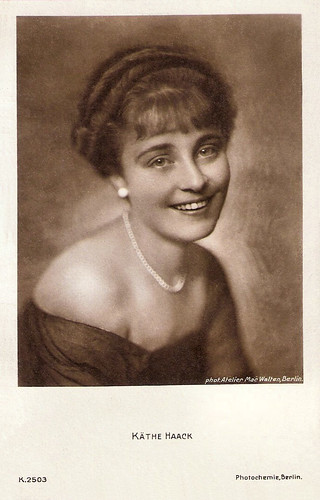
German postcard by Photochemie, Berlin, no. K. 2503. Photo: Phot. Atelier Walten, Berlin.

German postcard by Photochemie, Berlin, no. K. 1819. Photo: Alex Binder, Berlin.

German postcard by Rotophot in the Film Sterne series, no. 198/2. Photo: Becker & Maass, Berlin.

German postcard by Rotophot in the Film Sterne series, no. 198/3. Photo: Becker & Maass, Berlin. Collection: Didier Hanson.
Good-natured to vicious
Käte Lisbeth Minna Sophie Isolde Haack was born in Berlin, Germany, in 1897. She was the daughter of cloth merchant Karl Wilhelm Paul Haack and his wife Sophie Margaret Haack, née Jahn.
After attending a private lyceum in Berlin-Charlottenburg, she took acting lessons with Seraphine Détschy and Hans Kaufmann. In 1914 she received her first engagement at the Stadttheater Göttingen (City Theater Goettingen).
From 1915 on she played most of the time in the theatres of Berlin. Her roles included Anni in Ferenc Molnár's 'Spiel im Schloss' (Play in the Castle), Clara in the premiere of 'Der fröhliche Weinberg' (The Merry Weinberg) in 1925, and Mayor Gülstorff in the premiere of 'Der Hauptmann von Köpenick' (The Captain from Köpenick) at the Deutsche Theater in 1931, directed by Heinz Hilpert. From 1935 to 1944 she worked at the Preußischen Staatstheater Berlin (Prussian State Theater in Berlin) under Gustaf Gründgens.
In 1915, she had her first film appearance in Pension Lampel (Max Mack, 1915) opposite Hanni Weisse. After a highly praised performance in Mack's Der Katzensteg/The Cat Walk (Max Mack, 1915), Haack further pursued her film career.
During the 1910s she portrayed a wide range of good-natured to vicious characters in such films as Das Tagebuch des Dr Hart/The Diary Of Dr Hart (Paul Leni, 1916) opposite her later husband Heinrich Schroth, Die Hochzeit im Excentricclub/Marriage at the Excentricclub (Joe May, 1917) written by Fritz Lang, and in the title role of the detective film Die Ratte/The Rat (Harry Piel, Joe May, 1918) opposite Heinrich Schroth as Joe Deebs.
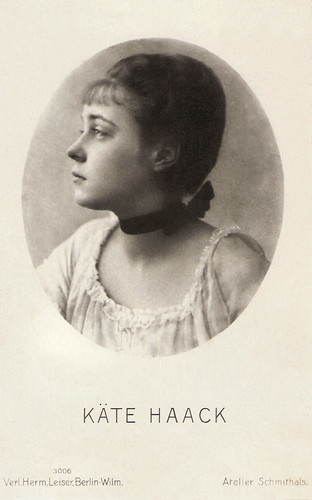
German postcard by Verlag Herm. Leiser, Berlin-Wilm., no. 3006. Photo: Atelier Schmithals.

German postcard in the Film-Sterne series by Rotophot, no. 542/2. Photo: Messter-Film, Berlin. Viggo Larsen and Käthe Haack in Der Sohn des Hannibal/The Son Of Hannibal (Viggo Larsen, 1918).

German postcard in the Film-Sterne series by Rotophot, no. 542/3. Photo: Messter-Film, Berlin. Viggo Larsen and Käthe Haack in Der Sohn des Hannibal/The Son Of Hannibal (Viggo Larsen, 1918).
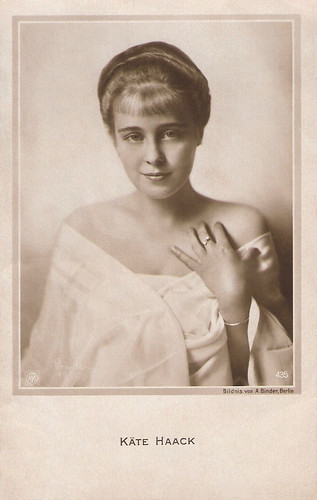
German postcard by Rotophot, no. 436, 1916. Photo: Alex Binder, Berlin.
German postcard by Photochemie, Berlin, no. K. 1818. Photo: Alex Binder, Berlin.
Rave reviews
In the 1920s, Käthe Haack was more or less reduced to parts of dull bourgeois women or amiable housewives in such successful productions as Der tote Gast/The Dead Guest (Karl Freund, 1921), Hedda Gabler (Franz Eckstein, 1924) starring Asta Nielsen, and Der alte Fritz/The Old Fritz (Gerhard Lamprecht, 1927) with Otto Gebühr. The extremely versatile actress received numerous role offers and could easily continue her career after the end of the silent era. She changed her image from a ‘young and street-smart girl’ to a wife and mother.
During the 1930s, Haack was one of the most successful and popular actresses. She appeared in box office hits like Berlin - Alexanderplatz (Phil Jutzi, 1931) starring Heinrich George, Emil und die Detektive/Emil and the Detectives (Gerhard Lamprecht, 1931) as Emil’s mother, Der Hauptmann von Köpenick/The Captain from Köpenick (Richard Oswald, 1931), and Pygmalion (Erich Engel, 1935) starring Jenny Jugo. During the war period, she starred in elaborate large-scale productions like the biography Bismarck (Wolfgang Liebeneiner, 1940) and the monumental Münchhausen/The Adventures of Baron Munchhausen (Josef von Báky, 1943) starring Hans Albers.
After the Second World War II, she remained one of the best-known and most successful German cinema actresses. She played in films ranging from melodramas like Herz der Welt/The Alfred Nobel Story (Harald Braun, 1952) to crime films like Dynamit in grüner Seide/Death and Diamonds (Harald Reinl, 1968) starring George Nader, and to comedies like Der letzte Fußgänger/The Last Pedestrian (Wilhelm Thiele, 1961) with Heinz Erhardt. A type of role she often portrayed at the end of her career was the distinguished ‘Grande Dame’. For this role in Der Lord von Barmbeck/The Lord of Barmbeck (Ottokar Runze, 1973) and Grete Minde – Der Wald ist voller Wölfe/Grete Minde - The forest is full of wolves (Heide Genée, 1977), she received rave reviews.
She remained also successful as a theatre actress in Berlin. Important post-war stage roles were Mrs Antrobus in 'Wir sind noch einmal davongekommen' (We got away once more, 1946, Hebbel-Theater), Mrs Higgins in 'My Fair Lady' (1963, a tour with 1500 performances) and Louise Mask in Carl Sternheim's 'Der Snob' (The Snob, 1966, Renaissance Theater).
In 1967 she was appointed ‘Berlin State Actress’ and in 1973 she was awarded the Filmband in Gold for her long and outstanding achievements in the German film industry. Haack published her memoirs under the title 'In Berlin und Anderswo' (In Berlin and elsewhere) in 1971. Käthe Haack died in 1986 in her hometown Berlin. Her daughter, Hannelore Schroth and her stepsons, Heinz Schroth aka Heinz Sailer and Carl-Heinz Schroth, were well-known actors.
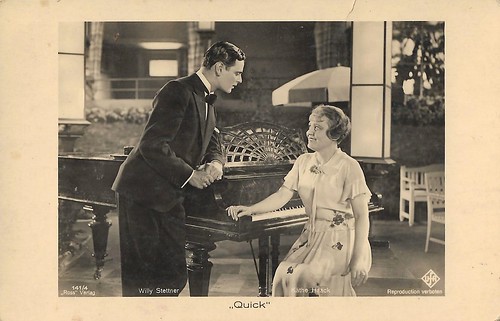
German postcard by Ross Verlag, no. 141/4. Photo: Ufa. Käthe Haack and Willy Stettner in Quick (Robert Siodmak, 1932).

German collectors card in the series 'Vom Werden deutscher Filmkunst - Der Tonfilm', album no. 11, picture no. 135. Photo: Aafa / Ross Verlag. Inge Landgut and Käthe Haack in Hanneles Himmelfahrt/Hannele's Ascension (Thea von Harbou, 1934).
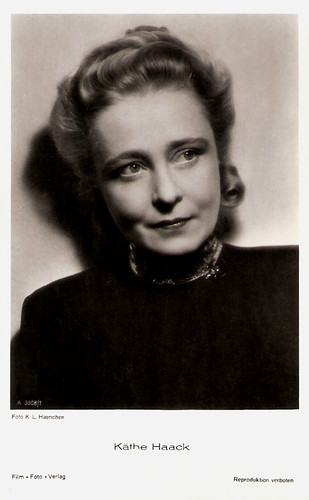
German postcard by Film-Foto-Verlag, no. A 3808/1, 1941-1944. Photo: K.L. Haenchen.
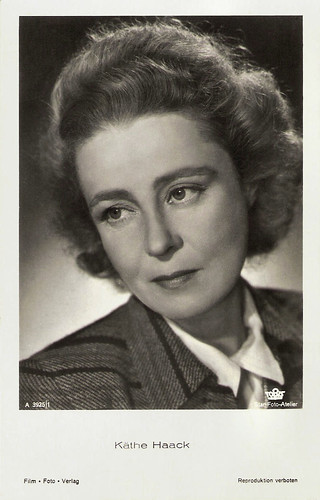
German postcard by Film-Foto-Verlag, no. A 3925/1, 1941-1944. Photo: Star-Foto-Atelier / Tobis.
Sources: Stephanie D’heil (Steffi-line - German), Thomas Staedeli (Cyranos), Filmportal, Wikipedia (German), and IMDb.
This post was last updated on 23 July 2024.
No comments:
Post a Comment